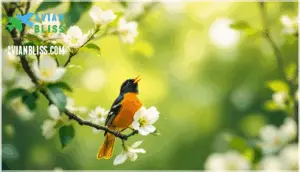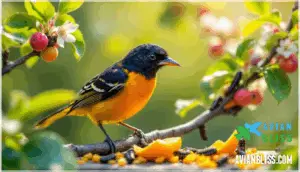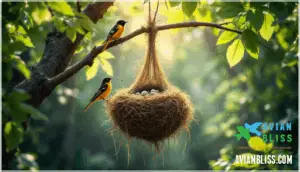This site is supported by our readers. We may earn a commission, at no cost to you, if you purchase through links.
 A flash of flame-orange against green leaves stops you mid-stride—that’s the Baltimore oriole, one of North America’s most visually arresting songbirds. Males wear a costume of fire and shadow: vivid orange underparts meet jet-black heads, wings, and tails, while females trade drama for subtlety in olive-brown and muted yellow.
A flash of flame-orange against green leaves stops you mid-stride—that’s the Baltimore oriole, one of North America’s most visually arresting songbirds. Males wear a costume of fire and shadow: vivid orange underparts meet jet-black heads, wings, and tails, while females trade drama for subtlety in olive-brown and muted yellow.
These skilled weavers build gravity-defying sock-like nests that dangle from tall deciduous branches across eastern forests, suburban parks, and backyards each spring. They’re long-distance athletes too, crossing the Gulf of Mexico in marathon 18-hour flights between breeding grounds and tropical wintering sites.
Understanding their identification markers, habitat preferences, migration timing, dietary needs, and breeding habits helps you spot these stunning visitors and support their survival.
Table Of Contents
- Key Takeaways
- Baltimore Oriole Identification and Appearance
- Baltimore Oriole Habitat and Range
- Baltimore Oriole Migration Patterns
- Baltimore Oriole Diet and Feeding Behavior
- Baltimore Oriole Breeding and Conservation
- Frequently Asked Questions (FAQs)
- How long do Baltimore Orioles stay around?
- When should I put out my Baltimore Oriole feeder?
- Why is it called a Baltimore Oriole?
- What trees do Baltimore Orioles nest in?
- How long do Baltimore orioles typically live?
- Can Baltimore orioles be kept as pets?
- Do Baltimore orioles return to the same nests?
- What predators pose threats to Baltimore orioles?
- How do Baltimore orioles communicate with each other?
- How long do Baltimore Orioles typically live?
- Conclusion
Key Takeaways
- Male Baltimore orioles display flame-orange underparts with jet-black heads and wings, while females show subtler olive-brown and yellow plumage, making identification straightforward once you know these sex-specific color patterns.
- These birds construct remarkable hanging sock-like nests through up to 10,000 individual stitches, suspending them 6–90 feet high on slender branch ends where predators can’t easily reach, with 85% of nests remaining structurally sound for over a year.
- Baltimore orioles complete grueling 18-hour nonstop flights across the 500-mile Gulf of Mexico during migration between eastern North American breeding grounds and Central American wintering sites, with populations declining 36% since 1966 due to habitat loss and pesticide exposure.
- You can support their conservation by setting out feeders with sugar-water (1:5 ratio), fresh oranges, and grape jelly in early-to-mid April, while planting native fruiting trees like mulberry and reducing window collisions to protect both migrants and residents.
Baltimore Oriole Identification and Appearance
If you’ve ever caught a flash of fiery orange darting through the treetops, you might’ve spotted a Baltimore Oriole. This bird’s vibrant colors make it one of the easiest songbirds to recognize, but there’s more to identification than just vivid plumage.
Here’s what you need to know to tell these orioles apart in the field.
Male Plumage Characteristics
Adult male Baltimore orioles display striking sexual dimorphism through their vibrant plumage carotenoids, which create vivid flame-orange underparts contrasting sharply with jet-black heads, backs, wings, and tails. You’ll notice two prominent white wing bars against the darker feathers, while the orange coloration extends to the rump and outer tail feathers.
This feather structure contains melanin and carotenoid pigments that scatter light, enhancing color vibrancy during courtship displays. Maturation effects become apparent as first-year males show duller yellow-orange tints before developing complete adult plumage by their second breeding season, with testosterone-driven carotenoid absorption intensifying coloration.
In hybrid coloration zones with Bullock’s orioles, males exhibit intermediate brightness reflecting genetic introgression, while molt variations—including the complete prebasic molt after breeding—affect seasonal color saturation throughout their annual cycle.
Female and Juvenile Plumage
Female Baltimore Orioles and young males display orange-yellow underparts with olive-brown upperparts, contrasting with the males’ bold patterns—a textbook example of sexual dimorphism. You’ll spot dusky-brown heads and two straight-edged white wing bars that help distinguish the species from Bullock’s orioles.
Key identification features for female and juvenile plumage:
- Female coloration: Orange-yellow below, mottled olive-brown above with dusky-gray wings
- Juvenile development: Lighter tones than adults, with brown juvenile feathers contrasting against black post-molt feathers
- Molt patterns: Complete prebasic molt occurs before fall migration, darkening plumage progressively with age
- Age variation: After-hatch-year females display blackish wings, while hatch-year individuals retain lighter olive-brown tones
- Genetic variation: Plumage differences reflect age, geographic origin, or hybridization in overlapping ranges
Females darken over successive seasons, sometimes approaching male coloration in later life.
Size, Shape, and Anatomy
Beyond plumage features, you’ll notice the Baltimore Oriole’s medium build—17–22 cm long with a 23–32 cm wingspan—places it between a sparrow and robin in scale. Males slightly exceed females in body dimensions, reflecting subtle sexual dimorphism.
The bill structure is conical and pointed, measuring roughly 18–22 mm, adapted for piercing fruit and extracting nectar. Skeletal anatomy includes a strong sternum supporting powerful flight muscles and an anisodactyl toe arrangement for secure perching.
| Physical Characteristics | Measurement Range |
|---|---|
| Body length | 17–22 cm (6.7–8.7 in) |
| Wingspan | 23–32 cm (9.1–12.6 in) |
| Body weight | 22.3–42 g (0.79–1.48 oz) |
| Bill length | 18–22 mm |
Distinctive Songs and Calls
Male Baltimore Orioles deliver rich, flute-like songs lasting 0.8–2.6 seconds—each phrase utterly unique, never replicated by another individual. You’ll hear sharply descending pitch inflections that make their vocalizations unmistakable during breeding season. Females also sing, which is rare among songbirds, and pairs sometimes perform synchronized duets to strengthen their bond.
Song learning occurs through auditory imitation, blending innate templates with environmental influences, leading to impressive song variation across populations.
Beyond melodic songs, you’ll encounter:
- Chatter calls repeated 2–30 times during territorial disputes
- Sharp begging calls from nestlings requesting food
- Harsh alarm chatter signaling predators or threats
- Screech-like calls from nesting females defending their young
- Acoustic motifs borrowed from sympatric species interaction, reflecting adaptive vocal flexibility
Comparison With Similar Oriole Species
When sorting through eastern avian species, plumage differences help immediately. Orchard Oriole males show deep chestnut underparts instead of orange, and they’re smaller—about 6–7 inches versus the Baltimore’s 7–8.5.
Out west, Bullock’s Oriole shares a hybridization zone with Baltimore along the Great Plains, though DNA studies confirmed they’re distinct species.
Hooded Orioles prefer southwestern palms with slimmer builds, while habitat segregation keeps Orchard Orioles in lower orchards and Baltimore in taller canopy trees. A key identifier is that the orchard oriole is smaller than the Baltimore Oriole.
Baltimore Oriole Habitat and Range
Baltimore Orioles don’t just pick any random tree to call home—they’re selective about where they breed, nest, and raise their young. Understanding their habitat preferences helps you know where to look for these striking birds across the continent.
Let’s break down the environments where you’re most likely to spot them.
Preferred Breeding Environments
You’ll find Baltimore Orioles breeding where open deciduous woodlands meet opportunity—river edges, parks, and tree-lined neighborhoods across eastern North America. They favor tall shade trees like elms, maples, and sycamores for nest sites, positioning their hanging pouch nests 15–30 feet high in flexible outer branches. Water proximity improves breeding territory quality, while moderate canopy cover balances foraging access with concealment.
Urban adaptation has proven successful where mature deciduous trees persist and pesticide use remains limited. These birds belong to the blackbird family, closely related to species like the Eastern Meadowlark.
Geographic Distribution in North America
You’ll encounter Baltimore Orioles across eastern North America’s breeding range, stretching from southern Canada—including Manitoba, Ontario, and Quebec—through the Great Lakes and Mid-Atlantic to northern Georgia and Mississippi. Regional presence peaks in Maryland, Minnesota, and Illinois where deciduous woodlands thrive. Western breeding boundaries reach eastern Montana, where range overlap with Bullock’s Oriole creates hybridization zones.
Canadian distribution follows the southern Boreal Forest edge, while migration corridors trace the Mississippi Basin and Appalachian foothills connecting breeding range to winter range in Central America.
Adaptation to Urban and Suburban Areas
You’ll find Baltimore Orioles thriving in human-modified landscapes—suburban backyards, parks, and urban environments—where they’ve adapted remarkably well. Urban nesting occurs in tall shade trees like maples and sycamores, with females weaving synthetic materials into their hanging pouches.
Diet shifts toward backyard feeders offering oranges and nectar supplement natural foraging. Habitat fragmentation remains challenging, yet conservation efforts promoting bird-friendly environments and native plantings help stabilize urban populations despite ongoing human influence.
Baltimore Oriole Migration Patterns
Baltimore Orioles don’t stick around when the seasons shift—they’re long-distance travelers with precise schedules and routes. Understanding their migration patterns helps you know when to expect them in your area and what obstacles they face along the way.
Here’s what you need to know about their seasonal movements.
Spring Arrival and Fall Departure
You’ll notice Baltimore Orioles arrive in Texas and Gulf states by early April, spreading northward as temperatures rise and insects emerge. Peak arrival across the breeding range spans mid-April through mid-May, with northern populations like those in Michigan appearing around early May.
Departure cues kick in as daylight drops below 13 hours in late summer—most birds leave by late August, completing their long-distance bird migration to winter range destinations within 30 to 45 days. Climate impacts are shifting these migration patterns earlier each spring.
Migration Routes and Timing
You can track Baltimore Oriole migration along two primary flyways: the Central and Mississippi corridors, where over 300 migratory birds funnel through during peak spring and fall movements. Gulf crossings present the most dramatic leg—a 500-mile non-stop flight lasting up to 18 hours, demanding remarkable endurance and favorable weather impacts.
Key migration patterns include:
- Flyway variations: Spring routes traverse Texas northward through the Midwest by mid-May, while fall departure peaks in August with Canadian birds leaving earliest
- Stopover ecology: Fruit and insect availability at rest sites determines migration pace, with persistent headwinds adding several days to the journey
- Juvenile migration: First-year birds follow the same long-distance bird migration pattern but may travel shorter distances due to inexperience
Wintering Grounds in The Tropics
After crossing the Gulf, Baltimore Orioles spread across a vast winter range from southern Florida through Mexico, Central America, and into northern South America—reaching Colombia and Venezuela.
You’ll find them thriving in tropical habitats like shade-grown coffee farms and cacao plantations, where they join mixed flocks with tanagers and honeycreepers. Their winter diet shifts to nectar, soft fruits, and occasional insects, while social interactions replace breeding territoriality.
Conservation efforts focus on protecting these agricultural landscapes, as deforestation and climate impacts threaten migration success.
Challenges During Migration
Baltimore Oriole Migration faces steep odds. Habitat fragmentation along flyways leaves fewer safe stopovers, while light pollution disorients nocturnal travelers—causing deadly building collisions that kill hundreds of millions annually.
Pesticide exposure weakens immune systems and depletes insect prey. Predation risks from outdoor cats claim billions of birds yearly.
Climate change disrupts breeding timing, forcing range shifts northward and threatening long-distance bird migration success across generations.
Baltimore Oriole Diet and Feeding Behavior
Baltimore Orioles shift their menu throughout the year, balancing protein-rich insects with energy-packed fruits and nectar. You’ll find these birds using clever foraging tactics high in the canopy, and you can bring them to your own yard with the right offerings.
Here’s what you need to know about their diet and feeding habits.
Insect and Invertebrate Prey
During breeding months, you’ll see these birds targeting protein-rich insects like caterpillars, beetles, grasshoppers, and spiders throughout the forest canopy. Their prey selectivity becomes especially valuable for pest control—they consume tent caterpillars and webworms that damage deciduous trees.
Foraging altitude usually ranges from 6 to 45 feet, where larval consumption peaks when raising nestlings. This seasonal diet shift toward insects provides essential nutrients for reproduction before late summer.
Fruit and Nectar Consumption
When breeding wraps up, you’ll notice a major dietary pivot toward sugary resources that fuel long flights. Orioles target ripe, dark-colored fruits—mulberries, cherries, and blackberries—plus flower nectar from native blooms and fruit tree blossoms.
- Fruit preferences: Overripe oranges, berries, and even grape jelly at feeders provide simple carbohydrates for pre-migration fat storage
- Nectar sources: Sugar-water mixtures (20–25% sucrose) and hummingbird feeders supplement natural nectar when insects decline
- Seasonal intake: Spring and fall diets shift to 75% fruit and nectar, reversing summer’s insect focus to meet migration energy demands
These nectarivores metabolize glucose into subcutaneous lipid reserves—essential for flights exceeding 1,200 km without rest.
Foraging Techniques in The Wild
You’ll spot orioles performing signature moves as they hunt. Their primary foraging techniques include insect gleaning from leaves and bark, aerial foraging to snag flying prey, and gaping habit—prying open fruit with their strong beaks.
Seasonal shifts drive habitat preferences: summer means canopy insect consumption; migration triggers nectar feeding and fruit raids. These adaptive food sources keep orioles fueled year-round.
Attracting Orioles to Backyard Feeders
With proper feeder placement and seasonal timing, you can turn your yard into an oriole hotspot. Follow these evidence-based strategies:
- Nectar recipes: Mix sugar-water at 1:5 ratio—skip red dyes, which orioles avoid
- Bird feeders: Choose orange-colored platforms with 1.25 cm ports, hung 5–7 feet high near water
- Fruit offerings: Provide fresh oranges and grape jelly (under 1 tablespoon)
Hygiene practices matter: clean feeders every 3–5 days with a vinegar solution.
Habitat enhancement—planting native fruit trees like mulberry—doubles Baltimore Oriole visits while supporting their sugarwater and nectar needs year-round.
Baltimore Oriole Breeding and Conservation
Baltimore Orioles build some of the most recognizable nests in North America, but their populations face real challenges from habitat loss and pesticide use.
Understanding their breeding biology and the conservation threats they encounter helps you support these vibrant birds in meaningful ways. The following sections break down how orioles raise their young and what you can do to protect them.
Nest Building and Materials
When you watch a female oriole build her nest, you’re witnessing one of nature’s most intricate construction projects—she’ll complete up to 10,000 individual stitches using only her beak. Nest construction follows three distinct phases: weaving an outer bowl from flexible plant fibers, forming an inner layer of springy material, and lining the chamber with downy fluff like milkweed silk.
A female oriole completes up to 10,000 individual stitches using only her beak to weave her intricate hanging nest
Material adaptation varies by region—you might see her incorporating grasses, bark strips, yarn, or even fishing line. The nest placement strategy prioritizes safety, suspending the pouch 6–90 feet high on slender branch ends where predators struggle to reach. Protective adaptations include the deep, bag-like design with a narrow entrance, deterring snakes and parasitic cowbirds. Remarkably, roughly 85% of these structures demonstrate considerable nest durability, remaining intact for over a year.
| Construction Phase | Materials Used | Primary Function |
|---|---|---|
| Outer Bowl | Plant fibers, grapevine bark, grasses | Structural framework and attachment |
| Inner Bowl | Springy fibers, hair, wool | Flexibility and shape retention |
| Lining | Milkweed silk, cottonwood fluff, animal hair | Insulation and cushioning for eggs |
| Reinforcement | Yarn, twine, cellophane (near human areas) | Additional structural integrity |
Mating Rituals and Parental Care
Right after males arrive at breeding grounds in spring—sometimes days before their future partners—courtship displays begin with dramatic bowing, wing-lowering, and tail-fanning that showcases their vibrant orange plumage. Females respond with wing-quivering signals when receptive.
Once paired, mating rituals quickly shift to parental roles: females undertake nearly all incubation duties over 11–14 days, while males defend territory and occasionally deliver food. After hatching, both parents feed altricial nestlings through regurgitation, then continue fledgling care for roughly two weeks post-fledging, teaching foraging skills and predator recognition.
Breeding success hinges on nest fidelity to protected sites, canopy cover, and abundant insect prey during this intensive parental care period.
Population Trends and Threats
You’re witnessing a quiet crisis: Baltimore Oriole populations dropped 36% from 1966 to 2019—that’s roughly 0.84% annually—driven by habitat loss, pesticide contamination, and climate change.
Habitat fragmentation removes nesting sites; migration hazards like building collisions and tropical deforestation worsen mortality.
Climate impacts could erase Maryland’s breeding range by 2080. Despite this population decline, the conservation outlook remains cautiously monitored rather than critical.
Conservation Efforts and Bird-Friendly Practices
You can reverse this decline through habitat restoration, pesticide reduction, and urban design that support conservation. Programs like Baltimore’s Oriole Garden integrate native plants, while community engagement through citizen science tracks population trends.
Bird-friendly practices—planting fruiting trees, reducing window collisions, supporting shade-grown coffee—protect migration corridors and wintering grounds. These conservation efforts directly counter habitat loss, making avian conservation accessible to everyone.
Frequently Asked Questions (FAQs)
How long do Baltimore Orioles stay around?
In the Victorian era, birders would have eagerly awaited their spring return—and you’ll see them for about five to six months each year.
Baltimore Orioles arrive between early April and late May for their breeding season, then migrate south by early October, completing their annual cycle across continents.
When should I put out my Baltimore Oriole feeder?
You’ll want to set up your feeder in early to mid-April, before spring arrival peaks. Best Timing and Regional Variations matter—southern areas see migrants earlier than northern zones.
Offer Nectar, Fruit, and options mimicking Baltimore Oriole Diet.
Strategic Feeder Placement and Deterring Pests boost success matching Oriole Feeding Actions.
Why is it called a Baltimore Oriole?
The species takes its name from the heraldic colors of England’s Baltimore family—Lord Baltimore, whose coat of arms featured striking orange and black.
Early colonists in Maryland noticed the male Baltimore Oriole’s plumage matched those symbolic colors perfectly, linking the bird’s appearance to the family’s legacy.
What trees do Baltimore Orioles nest in?
You’ll find their pendulous nests hanging from the outer branches of tall deciduous trees—particularly maples, oaks, and sycamores.
These trees offer sturdy limbs at appropriate heights and open canopies that aid nest building and fledgling flight.
How long do Baltimore orioles typically live?
In the wild, you’ll find Baltimore Orioles usually living 6 to 8 years, though factors like predation, threats to Baltimore Oriole population, and mortality causes from habitat loss can reduce average longevity.
Maximum age records reach 12 years, while captivity lifespan extends beyond wild expectations due to controlled conditions.
Can Baltimore orioles be kept as pets?
Keeping songbirds as pets is possibly the fastest way to land in legal hot water. Baltimore Orioles can’t be kept as pets in the United States. Federal law protects them under the Migratory Bird Treaty Act, making captivity illegal without permits.
Their specialized diet and habitat needs make ethical care nearly impossible.
Do Baltimore orioles return to the same nests?
Baltimore Orioles don’t return to the same nests. Their pendulous woven structures deteriorate during winter, so females build fresh nests each season.
Offspring return to similar breeding territories, but nest site fidelity involves constructing new nests rather than nest reuse frequency.
What predators pose threats to Baltimore orioles?
Like Hitchcock’s birds descending without warning, predators strike from multiple angles. Hawks, crows, and jays raid nests for eggs and nestlings, while snakes climb to hanging pouches.
Cats threaten fledglings and adults near feeders, especially in suburban habitat.
How do Baltimore orioles communicate with each other?
You’ll hear them through rich, flutelike songs and sharp chattering calls. Males sing from high perches to defend territory and attract mates, while both sexes use alarm calls to warn of predators.
Visual displays—wing flicks, tail fanning—complement these vocalizations during courtship and nest communication.
How long do Baltimore Orioles typically live?
In the wild, you can expect most Baltimore Orioles to live between 6 and 10 years, though their average longevity usually falls around 6-7 years. Natural threats like predation, harsh weather, and migration challenges influence lifespan factors considerably.
Captivity lifespan records show some individuals surviving beyond 12 years.
Conclusion
Think of each Baltimore oriole as a living thread in a larger tapestry—one woven across hemispheres, seasons, and ecosystems. Your ability to recognize their field marks, understand their migratory journeys, and provide habitat support directly strengthens that fabric.
Whether you’re offering grape jelly at a feeder or planting native fruiting trees, you become part of their survival story. Observing a Baltimore oriole isn’t just witnessing beauty; it’s participating in a continental conservation effort that depends on everyday actions in backyards and parks.
- https://app.mybirdbuddy.com/compare/baltimore-oriole-vs-orchard-oriole
- https://www.allaboutbirds.org/news/a-deep-dive-into-the-oriole-genome-tackles-the-mystery-of-hybridization/
- https://royalsocietypublishing.org/doi/10.1098/rsos.221211
- https://www.earthofbirds.com/hooded-oriole-vs-baltimore-oriole/
- https://www.inwoodlands.org/the-birders-dozen-profile-balt/












